Types of Turkey Callsand When to Use Them
By Dan Young | Updated:
Turkeys have a language all their own, which we can imitate with the correct call. The largest fowl in North America was once an important food source for Native Americans and early European settlers, and it remains one of the most popular upland game birds.
Turkeys are crafty, intelligent, and amazingly fast and agile for a bird of their size. Turkey hunting varies greatly across the United States. Eastern turkeys are hard to locate in heavy cover, and their Western relatives are difficult to slow down as they race across meadows and even open grassland with endurance that will exhaust a pursuing horse.
Calls help us get the attention of turkeys, especially gobblers. We’ll review the most popular styles of calls and explain how, when, and where they work.
Types of Turkey Calls
There are various types of turkey calls, which serve distinct purposes. In this article, we’ll review:
- Box
- Diaphragm
- Pot and striker
- Push button
- Locater
Listed below you’ll find detailed information on the style, use and effectiveness of the five major types of turkey calls.
| Type of Call | Purpose | When to Use |
|---|---|---|
| Box | Produces a wide variety of sounds with great range, up to several hundred yards | In the early morning and late evening when toms first hit the ground from their roost or are about to return |
| Diaphragm | To call turkeys in at close range while keeping your hands free | In the final approach of a tom, when he’s within 50 yards of our location |
| Pot and striker | Call with the most expressive arrange of turkey sounds, and with great volume, a go-to in getting toms to move in from a distance | Use it similar to a box call. It works great in early morning and late evening when toms are leaving or returning to the roost |
| Push-button | Easiest turkey call to master. It has good range and produces a good variety of sounds but isn’t as versatile as a box, diaphragm, or post and striker | When you hear a tom gobble, you can answer with this call, then mimic the sounds of a hen and chicks |
| Locator | A mouth-operated call similar to a duck or goose call that mimics the sound of rival birds such as crows, hawks, or owls. This call is used to enrage territorial toms | Use this call in the early morning, or in mid-day to alert a tom of a potential intruder. Make the initial call, then put this away and switch to one of the other calls. |
Box Calls
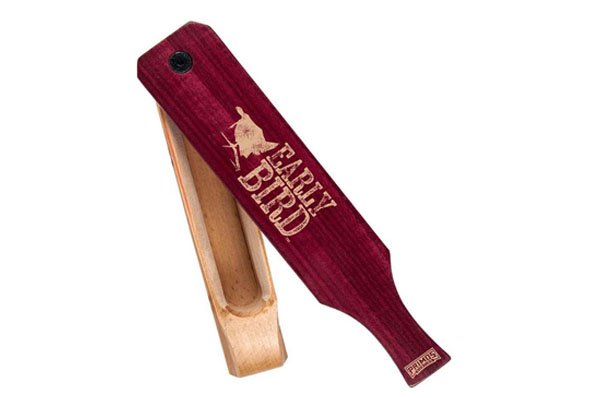
A box call is the go-to call for many turkey enthusiasts. Whether you’re a beginner or you’ve called toms for a long time, this call is one that works in a variety of settings. The mechanics of the box call are a simple design that has been used effectively for centuries.
A box of hardwood is attached to a lid, also called a scrapper. These boxes are typically walnut or oak in the Eastern states, and cedar out west. The tone of the box is tuned by carving out material inside the box to generate the correct sounds for chirps, clucks, cuts, purrs, cackles, and whines, all common sounds made by turkeys.
By pulling the lid or scrapper across the top of the box, sounds are generated. The one drawback to this design is in wet or snowy weather. The wood can swell, changing the tone or if it’s wet enough, taking away all the sound. This has been solved with metal boxes that are weatherproof and that will still generate sound when struck no matter how cold, wet, or windy the conditions become.
| Pros | Cons |
|---|---|
|
|
To use a box call:
- Find signs of turkey activity (footprints, scat, roosting site).
- Find good cover near these signs.
- Start calling with chirps and clucks (most effective in the early morning or late evening).
- When a tom calls back to you, answer with a cackle or combination of sounds.
Diaphragm Calls
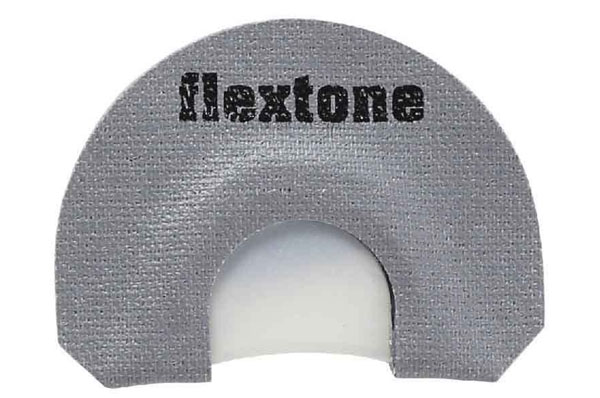
A diaphragm call is a small plastic device shaped like the outline of your teeth. With adjustment grooves in place to customize the diaphragm for individual callers this is one of the most realistic turkey calls you can find for a professional. By professional, we mean someone who has dedicated hundreds of hours in mastering this call.
The benefit of a diaphragm call is that it is hands free. You make the calls with it clenched loosely in your teeth, leaving your hands free for a camera or shotgun. The drawback to this call is its limited range. It won’t cover as much area with its sound as a box call will. This makes it ineffective if you’re trying to call turkeys in from a distance, but if you’ve located a good blind, there isn’t a better method of mimicking the sounds of these big birds than a diaphragm call.
Using the call in conjunction with a box call is often a good technique. The box call has a wider range, and once a bird answers your call, you can switch to the realistic, but lighter sounds produced by a diaphragm.
Diaphragms are more useful in eastern, heavily wooded calling than they are in wide open terrain often inhabited by western turkeys. The key is practice, without it, your pips, whines, yelps, and clucks won’t sound natural, and the birds will shy away from you.
| Pros | Cons |
|---|---|
|
|
Pot and Striker Calls
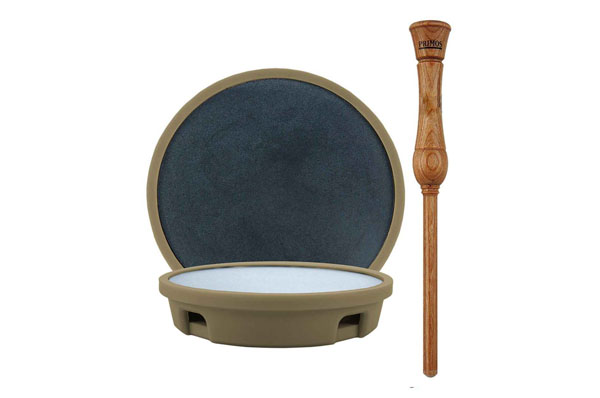
These oddly named calls can create the most array of turkey sounds in the hands of an experienced caller. They get their name from the design which resembles an ordinary cooking skillet, albeit much smaller, and the type of steel striker outdoorsmen use with flint to spark a fire.
To use pot and striker calls, you take the wood, carbon, or aluminum striker and rub it on the pot. The pot is usually made of glass, ceramic, or sometimes slate. If you’ve ever rubbed a wet finger on a wine glass and produced that high-pitched whining sound, you get the idea of how a pot and striker work.
They produce a wide range of sounds and don’t take nearly as long to master as a diaphragm call, but they do require both hands. They have great range, creating sounds on par with box calls and an additional benefit over the box call is that they are largely immune to weather.
You won’t need an introductory call as many diaphragm callers are often forced to try with a pot and striker. You can start with a locator call mimicking an owl, crow, or hawk, these are described in depth below. You can then switch to clucks, purrs, putts, and cutts before switching to the yelp, the sound a hen makes when gathering her clutch. These calls used correctly can get a big toms’ attention from several hundred yards away.
| Pros | Cons |
|---|---|
|
|
Push-Button Calls
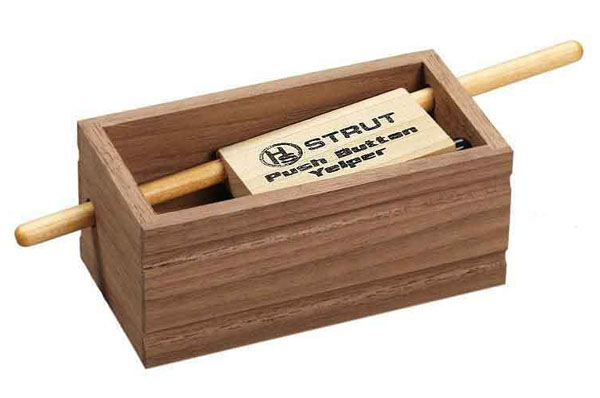
Many experienced turkey callers look down on push-button calls claiming they are just for beginners and no advanced caller would stoop to using one. Well, there are a lot of experienced callers who miss the chance to bring in a big gobbler because of that attitude.
Push-button calls are the easiest to learn and as such are often the starting point for novice turkey callers. A push-button call is a small box, made usually of cedar or walnut with an oak or walnut dowel inside. The dowel rubs against another piece of hardwood and creates sound as it creaks against the triangular-shaped wood.
You often find cheap push-button calls in souvenir shops, and they’re great at annoying parents on cross-country family vacations, but they’re even better at mimicking the sounds of a hen with chicks, a rival gobbler or even the challenging tone of a hawk or woodpecker.
Push-button calls have excellent range, and with practice can produce a wide variety of turkey sounds, but they too require both hands to use, limiting their practicality when a tom comes in close.
| Pros | Cons |
|---|---|
|
|
Locator Calls
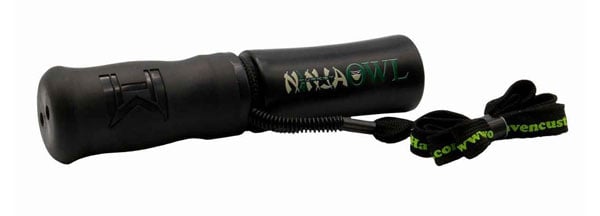
Seasoned turkey callers consider a locator call an absolute must. A locator call doesn’t mimic a turkey tom or hen at all, but rather creates the annoying sound of another bird intruding on a tom’s territory.
Locator calls mimic crows, hawks, woodpeckers, and owls, all birds that turkeys can’t stand within their domain. The locator call lives up to its name by locating gobblers. When a tom hears the sound of an owl or perhaps a crow, it calls back, letting the intruder know that this is his territory. There are few if any birds in North America that can stand up to a big tom turkey, so their aggression toward intruders is well-founded.
Once you’ve gotten a reply from a tom, it's time to put the locator call away and switch to another call that better mimics the sounds of a hen, chicks, or rival tom.
A locator call is very different than the other calls listed above. It resembles a duck or goose call more than any other type of turkey call, and since it’s not really calling a turkey, but rather challenging one with sounds from another species of bird, it makes sense that the call should look different as well.
| Pros | Cons |
|---|---|
|
|